TWH – Netflix announced in December that it has picked up a new series based on the classic Archie Comics’ character Sabrina, the teenage witch. The new show, as defined by Netflix, will “imagine the origin and adventures of Sabrina the Teenage Witch as a dark coming-of-age story that traffics in horror, the occult and, of course, witchcraft.”
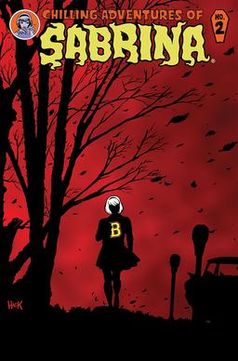
The yet-to-be-named series is riding on the popularity of the new CW series Riverdale, which plunges the famous Archie kids into a dark and more brooding narrative than anything seen before. The CW was originally flirting with a Sabrina companion series; however, Netflix decided to pick it up for two seasons and 20 episodes.
Netflix says,”Tonally in the vein of Rosemary’s Baby and The Exorcist, this adaptation finds Sabrina wrestling to reconcile her dual nature — half-witch, half-mortal — while standing against the evil forces that threaten her, her family and the daylight world humans inhabit.”
While the show’s character concept of Sabrina is based on the original 1960s Archie comic books, the show’s dark spin comes directly from Robert Aguirre-Sacasa’s graphic novel The Chilling Adventures of Sabrina which tells the story of Sabrina as 1960s teen fighting against Satan. Or, as an Entertainment Weekly reviewer recently wrote: “Sabrina Spellman as a teenager in the ’60s dealing with the occult and the hellish consequences of witchcraft.”
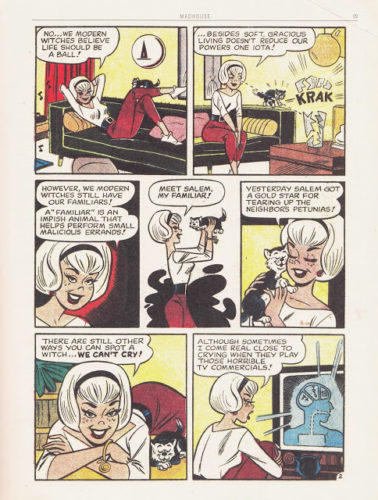
Sabrina the teenage witch has a long history in American visual entertainment. She first appeared in Archie Comics in 1962 as the lead story for Mad House issue #22, which aptly was released in October of that year. Creators George Gladir and Dan DeCarlo never expected Sabrina to be a hit, but she was.
Sabrina became a regular character in the Archie comic series and, in 1971, she eventually earned her own series titled “Sabrina the Teen Age Witch”.
In 1970, Sabrina made her debut as an animated character in the low-budget Filmation series’ Sabrina and the Groovey Ghoulies, which was renamed to Sabrina the Teenage Witch in 1971. The show aired from 1970 to 1974 during the CBS Saturday morning cartoon hours. Although the show went off the air in the 1974, CBS ran some of the episodes during the Archie Hour in 1978. They retitled her segments as Sabrina, the Super Witch. However, that Archie series was not popular, and the show went off the air that same year.
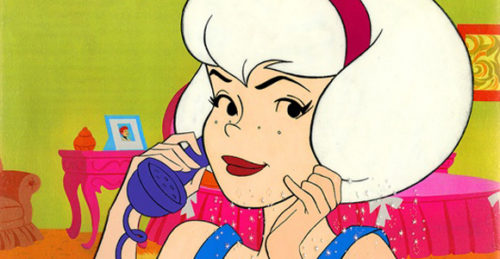
1970 Sabrina [CBS TV].
The new live-action sitcom, which was geared toward young teens, aired from 1996 to 2003, making a switch from ABC to the WB in 2000. Its launch and eventual success led to a new comic book series, a manga series, and several feature films including Sabrina Goes to Rome (1998) and Sabrina Down Under (1999). Hart as Sabrina also made cross-over appearances on other shows such as Boy Meets World (1997).
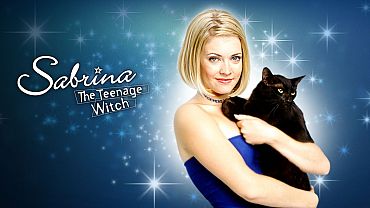
1996 Sabrina starring Melissa Joan Hart [ABC TV].
In all cases, these new animated production were geared at young audiences, rather than preteens or teens. By 2013, Sabrina had taken on a whole new look.
This is important point. Looking back at the original Archie comic books, Sabrina was created to resemble a 1960s pin-up, and her magical work was not something she was fighting against in anyway. While it was not evil in the sense of Rosemary’s Baby, it was considered mischief, and Sabrina was somewhat of a troublemaker and a flirt; she was designed sexualized and designed to be impish in nature.
In the first issue, Sabrina says that she is a modern witch, and shows no remorse for the fact that she cannot “fall in love.” She also explains that a witch’s familiar performs “small malicious errands.” These are exampled indicative of Sabrina’s original tone, which suggests the thematic idea that a modern, sexualized and empowered woman might be trouble. This theme is pervasive in occult-based of golden era Hollywood entertainment (e.g. Bell, Book, and Candle, 1958)
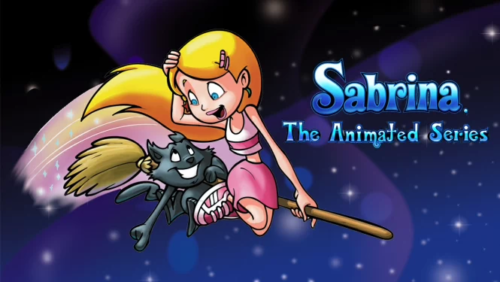
2000 Sabrina [Buena Vista TV].
As time passed, Sabrina took on the persona of the typical 1990s empowered young woman. Not only was she now real rather than being idealized in a drawn form, but her magical work, like that of the 1970s cartoon, was often accidental, foiled, and played simply for comedy. Hart’s live-action Sabrina is sympathetic and endearing, and her witchcraft is never dark or purposefully mischievous.
Regardless of the shift, magic was still an allegorical stand-in for female empowerment. In all narratives, Sabrina finds her magical power at the tender age of 16, a significant year and one that is often repeated in the telling of stories about teen girls (e.g., The Little Mermaid, 1989). However, unlike the original comic, the new series treats magic different. While the learning and use of witchcraft, allegorically speaking, are still part of the coming-of-age story, it is not considered purposeful mischief, evil, or linked to an over-expression of female physical sexuality.
Magic and witchcraft are purely part of the teens new found agency, something that must be negotiated and learned. This thematic nuance can be found throughout magical and fantasy entertainment of the 1990s and 2000s, such as in the case of Willow in the series Buffy the Vampire Slayer (1993-2007) or the sisters in Charmed.
From 1962 to 2013, Sabrina was transformed from a sexualized impish teen who uses her magic for mischief to the teen girl next door in the ABC sitcom to a playful young girl in the later animated series. That is a big jump in characterization for both Sabrina and for the defining of witchcraft. In 1962, witchcraft was a trouble. By 2013, witchcraft is reduced in many ways to fantasy, child’s play and, in some cases, part of a girl’s power.
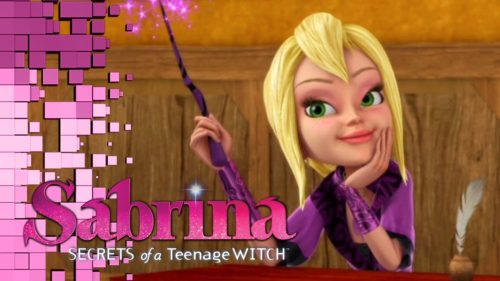
2013 Sabrina.
In 2014, Sabrina changed again, and that change will be realized in the Netflix series. Aguirre-Sacasa’s graphic novel was first published in 2014 by Archie Horror, a division of Archie Comics. The new shift in character tone coincides with the contemporary cultural trend toward dark fantasy and re-imaging fairy tales and other typically child-focused fare with adult themes. For example, this was done with Disney’s Maleficent (2014) and the television series ABC’s Once Upon a Time (2011 – ), to name two.
Riverdale, which was launched in January 2017 and is now airing on the CW, was created in this vein and corresponds to works published by Archie Horror. Aguirre-Sacasa is the show’s creator, and he is also the executive producer for the upcoming Netflix Sabrina series.
As noted in the press release, the new show will focus on Sabrina’s fight with darkness and, as is always the case, her coming of age. Sabrina will take on a new depth of character that depicts various sides of her personality, which is not reflected in past depictions. Sabrina gets a dark side that exceeds the original the simple impishness of the original comic character.
This shift in Sabrina’s characterization also changes the way that magic and witchcraft is portrayed. How the Netflix show will negotiate and define magic has yet to be seen? In shows like Buffy, Charmed, or the more recent shows Salem and American Horror Story: Coven, witchcraft could be used for both positive and negative actions. This usage was highly dependent upon the user and the motivation. The perceived morality concerning witchcraft becomes fluid, in these recent narratives. It isn’t tied to a definitive perspective.
However, if Netflix does what it suggests and uses Rosemary’s Baby or The Exorcist as a basis to define witchcraft, the use of magic may be strictly positioned as evil. Considering that Aguirre-Sacasa himself is the executive producer and writer of the new show and that his comics do lend themselves to this classic type of thematic structure with regard to occult themes, an “exorcist”- inspired depiction is very possible.
However, we will not find out until next year. The new show is slated to be released sometime in 2018.
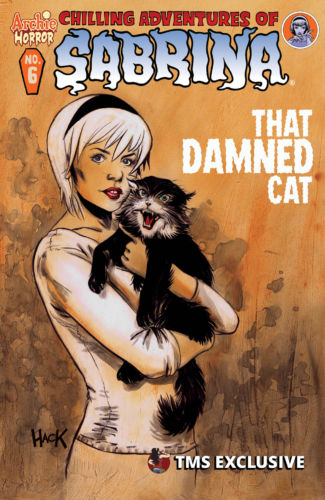
2014 Sabrina [Archie Comics].
The Wild Hunt is not responsible for links to external content.
To join a conversation on this post:
Visit our The Wild Hunt subreddit! Point your favorite browser to https://www.reddit.com/r/The_Wild_Hunt_News/, then click “JOIN”. Make sure to click the bell, too, to be notified of new articles posted to our subreddit.
